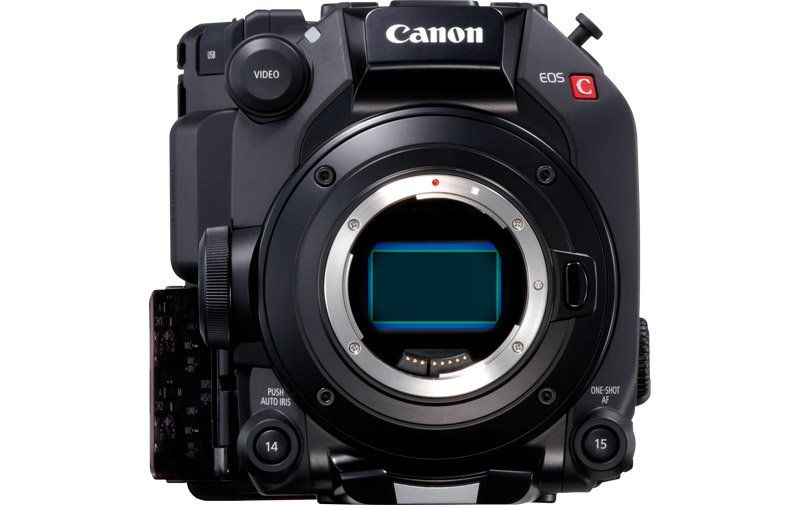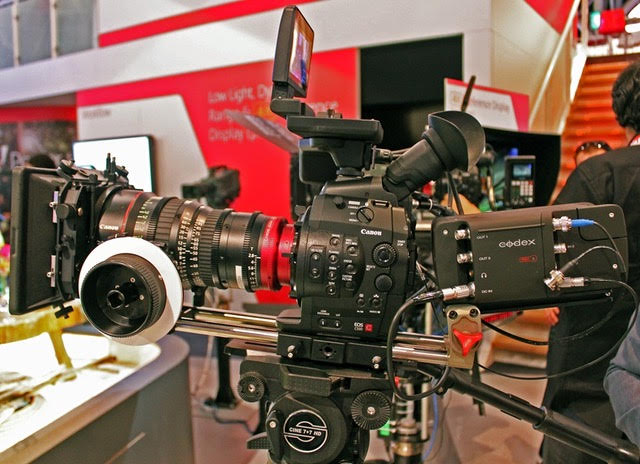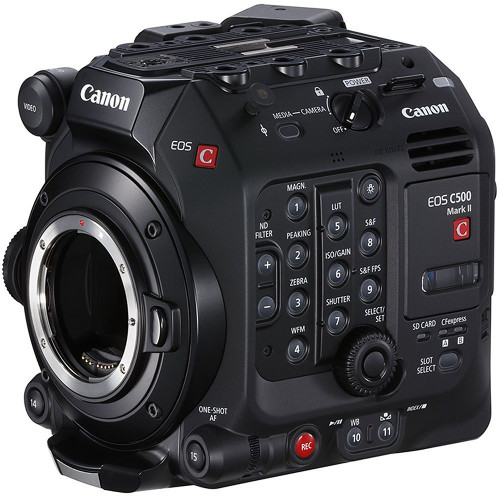Our pro video specialist Stuart Dennis makes the case for Canon’s recently announced C500 Mark II as a potential game-changer

“What is the most revolutionary camera you have dealt with?"
This was the question I posed to the Wex pro video team recently, and we all had different answers. One answered that the Canon EOS 5D Mark II was the ultimate in "game changing" as it impacted every camera release that succeeded it, and indeed that's a reason to consider it a genuine contender. One answered that the Sony FS7 was in the mix, and again that's a valid shout – 4K 60p off a Super 35mm sensor in an ergonomic and sub-£10k body. Another colleague said the Sony F55, as it quickly replaced 2/3" ENG shoulder-mount models as the workhorse for broadcast documentary work. The low-light magic of the Sony A7S was also mentioned.
With the obvious "5D Mark II" answer already taken, I reckoned on the Red One. Not because of its revolutionary compressed Raw format or even the fact that it was the first 4K cinema camera at a sub-£50k price point. No, it was that it made Arri create the Alexa series, a range of cameras that now enjoy the status of being the benchmark of quality in cinematic imagery.
But one colleague threw a curveball. Damien King, our Category Manager for Video (he owns Wex's online presence for all things video on our website) said the Canon C100 was the most revolutionary product he'd dealt with. He went on to explain that it was exactly the tool needed for the post-5D generation, combining the sensor of the original C300 with a manageable codec in a near-perfect "true video camera" body. It was a compelling argument and one that I still find myself referring to when appraising new releases.
Why am I telling you all of this? Well, the Canon C500 Mark II was announced yesterday, and in order to give a balanced and fair appraisal of this new model... context is everything.
Canon's 4K debut
In September 2012, whilst at the IBC exhibition in Amsterdam, I sat in the show theatre to see the first footage from Canon's Cinema EOS cameras that could shoot 4K. We first saw "The Ticket" shot on the 1DC by Shane Hulburt, and while this looked great, the second film was something special. "Man and Beast", shot by Jeff Cronenweth, was filmed on the original C500 in 4K using an external recorder to capture the 4K Raw output that the camera could deliver. Not just beautiful film in terms of narrative and content, it looked stunning, and demonstrated that Canon's 4K sensor technology and colour science were easily at a level suitable for feature films.
So the C500 ended up as a standard camera on many a cinematic release, right? Erm...not so much. The Arri Alexa train was picking up speed and new incarnations of the Red family were creating waves as well: the Japanese manufacturers struggled to find solutions that could ride the wake. Moreover, acquisition for cinematic production was only just coming to accept digital alternatives to film, and with Arri and Red positioning their cameras as the natural successors to analogue production... well, the reality is that the film industry initially settled on those two brands. Film and commercial work loves a "standard" – unsurprising, seeing as celluloid had been the benchmark for over half a century.
Beautiful as the footage was from a Canon C500 – and I say this as a staunch advocate of the Cinema EOS range since 2012 – the requirement of an external recorder made it a non-starter for commercial productions. The camera crew on a film set have a protocol and hierarchy that is rooted in film-based camerawork: that means the chain of DoP > Camera Op > Camera Assistant > Second AC > Focus Puller > Clapper Loader work in sync continually throughout a shoot, as has been the norm forever.
Why would the on-set management of external recorder be a problem, I hear you ask? After all, we're all used to them in 2019, right? Well, for narrative and commercial shoots in 2012-14 using the aforementioned camera crew hierarchy, the addition of an external recorder meant the crew needed to: a) know how another piece of kit outside of the camera OS worked, and b) rely on a cabled connection working at all times and the media on the recorder to being 100% stable. None of those things were a given at this time, and moreover the (now standard) on-set role of a Digital Imaging Technician (DIT) supporting this workflow was still in its infancy, meaning that more often than not there was no technician/expert on hand should any part of this chain fail.
To give you some context, the C500 worked best with the Codex Onboard-S recorder: a £12K solid state recorder originally designed for the first Arri Alexa cameras. For reference here's a photo of one at the 2012 IBC show:

The only other external recorder available that could handle the Raw signal from the C500 was the Convergent Design Odyssey 7Q, a 7" monitor/recorder with two SSD drives that split the 60p footage over both drives... and when I say "split", I mean it literally split the 60fps into two 30p streams over both drives. In post, you had to ingest and properly interpret the data from both drives (so you needed the Odyssey unit present to act like a VTR) to make up the full 60p video files. And if that post-process sounds longwinded, spare a thought for the camera people having to use the unit on a shoot: the Odyssey 7Q took around a minute (plus a hard reboot) to change input and recording settings *every time* you changed them.
(I've demoed and sold the C500 with both the Codex and Convergent Design recorders, and I can safely say that as a professional video specialist from 2006 onwards who has had to get his head around the complexities of bulky Sony HDCAM/Panasonic DVCProHD tape decks, early Red One workflows and much more, nothing makes me shudder like the thought of using an Odyssey again).
Cinema EOS goes 4K XF-AVC
The year 2014 saw the release of the Canon C300 Mark II, the 4K follow-up to the ubiquitous C300. This recorded broadcast-standard UHD and 4K in 10 Bit 4:2:2 and used a brand new 4K Super 35 sensor. Although the framerate in 4K disappointingly maxed out at 30p, the camera delivered a beautiful image that made it the choice of filmmakers who valued great skin tones and filmic colour reproduction over the decidedly more video-looking Sony FS7. Moreover, the XF-AVC codec recorded at a sensible 410mbps to widely available (and affordable) CFast cards, which was a big deal considering the aforementioned issues with the C500 and external recorders.
Our More Than an Image series, expertly made by DoP Tom Martin, is testament to the quality of the C300 Mark II image and indeed its unobtrusive no-external-recorder-necessary footprint: It was the perfect tool for sensitive documentary making and the results really do speak for themselves.
Canon adds 4K Raw – internally, this time
The lack of 50p in 4K was still something of an issue for Canon, so when the C200 was announced in 2017, it was great to see 4K 50p become a reality. Also a big deal was the implementation of the new Canon Raw Lite codec, a 1.5gbps compressed Raw filetype that offered 10-bit imagery at 50p and 12 bit in 25p. Finally, we had Raw off a gorgeous Canon Super 35mm sensor and onto CFast cards… so no more £15k Codex box or nightmares about Odyssey recorders.
But it wasn’t all rejoicing: the C200 was and remains a somewhat bi-polar tool, offering either 8-Bit 4:2:0 recording to SD cards at 150mbps or the aforementioned Canon Raw Lite recording to Cfast… and nothing in between. Indeed, Canon’s decision to not implement the full 10-Bit 4:2:2 XF-AVC format that had been so successful on the C300 Mark II was a confusing one: the C200 recorded either a format too low in bit-depth and chroma-subsampling qualify for UHD transmission, or a huge Raw file that broadcasters wouldn’t want to process.
It was clear that Canon were holding their broadcast codec back for a new model, perhaps a replacement for the C300 Mark II?
Kriss Hampton chats with Canon at IBC 2019 about the new C500 MK II
The C500 Mark II is announced
Last week Canon announced the newest member of the Cinema EOS line-up, the (rather confusingly titled) C500 Mark II. This camera is physically very similar to previous Cinema EOS cameras, which means it’s as compact and well-built as you’d expect, but now has two add-on modules that expand connectivity for SDIs and V-lock batteries, as well as having Canon’s first user-interchangeable lens mount, so you can swap from EF to PL whenever is necessary.

However, it’s on the inside that the camera really marks a change. The camera has a full-frame sensor and offers 5.9K Raw recording for full frame coverage; 4K Raw is also available in a Super 35mm crop whilst the 2K Raw crops down to a Super 16mm size field of view. The XF-AVC recoding codec that was missing on the C200 is now back and allows you shoot in either 4K or 2K off the whole of the sensor. 5.9k and 4K shooting are up to 60p, and just like the C300 Mark II, the 120fps in HD mode is cropped. It shares the industry-leading autofocus features of the C200 as well, although I’m not sure how many users will be using autofocus with a camera that’s likely to find its way onto feature and commercial shoots with dedicated focus pullers.
I mentioned that the “C500 Mark II” name was confusing. Why do I think that? Well, go back over everything I’ve said about the original C500. Does any of the spec of the new camera bear any resemblance to its “predecessor”? I think the answer is a definite “no”. The C500 Mark II is actually a combination of a C700 FF, a C200 and a C300 Mark II, not a continuation of the original C500. I really would have preferred it if the model name actually reflected that.
I began this piece by talking about “revolutionary products”, and when I said that I was really talking about cameras that were designed to change the game on purpose rather than by accident (apologies to the Canon 5D Mark II but… you’re in the second category). I think that with the C500 Mark II we might be seeing the first revolutionary Cinema EOS product: it ticks practically every current spec requirement in modern professional production but also comes in at a price that isn’t Arri/Red level.
Moreover, you could argue that the specs actually exceed what was expected of a follow up to previous models, and this is a big deal: Canon and their competitors will usually over-spec their photographic releases but professional video products are nearly always “just enough new stuff to see you through the next few years.” Well, the C500 Mark II does much more – and even if that’s not enough to qualify the camera as revolutionary… it certainly is for Canon.
What do you think of the C500? We’d love to hear your thoughts. Let us know by emailing provideo@wex.co.uk.
About the Author
Stuart Dennis heads up professional video here at Wex. He has been dealing with the kit requirements of professional filmmakers, camera operators and production companies for 14 years. Find him on Twitter? @Stuart_Dennis
Related articles
IBC 2019: Introducing the Sony FX9, the full-frame successor to the FS7/FS7 II
IBC 2019: Panasonic LUMIX confirm RAW output for the S1H
IBC 2019: Blackmagic unveils new ATEM Mini and Video Assist 12G HDR

